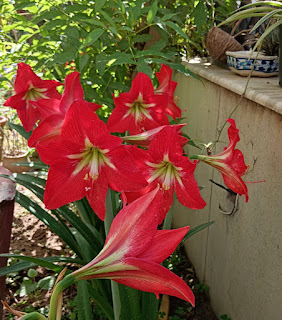When we moved into the ground floor apartment in Gurgaon, one of the first trees we planted was the Shiuli, more commonly known as the Harshingar or Parijat. Though my mother always had a shiuli plant in her well-maintained container garden, it had been a cherished wish of mine to have a shiuli tree of our own. Those lusciously fragrant dainty white flowers with their characteristic orange stems that fell as a carpet at the first touch of the sun tugged at my heartstrings. The sheer number of flowers laden on a tree planted directly in soil took the experience to another level. Those flowers and their heady fragrance held a lot of pleasant memories - of pujo, of the change of seasons and the onset of autumn, of my very identity as a Bengali.
 |
| Shiuli flowers from our tree |
The shiuli is a fairly large and tall tree, and an evergreen. It grows rapidly in the monsoon and requires a good pruning, so the flowers can come by autumn. But the flowering happens for only about a month in the entire year. And that month coincides with the peak festival season in most parts of India. Another reason why a glimpse of those flowers has happy associations.
Now the shiuli we planted in our front lawn started flowering right from the second year, giving us handfuls of white and orange every morning during season. As soon as the first rays of the sun touched the flowers, they would start dropping off, creating a fragrant carpet on the grass underneath. So we had a tradition of picking these flowers early morning, as soon as one was through with the morning ablution. Or sometimes between sips of hot tea. It was a revered tradition since the Bengali associate the shiuli flowering with the rise of the Divine Feminine.
 |
| Family tradition of Shiuli picking |
But each morning as I plucked the shiuli, a few flowers invariably landed on the aloe vera shrub next to it. And aloe has thorns. Every attempt to reach the fragile shiuli flowers and brush them off the aloe reminded me of simple life lessons.
That much like life, the good and bad, the soft and the prickly, always show up together. And we have to navigate through the thorns to get to the beautiful flowers. Just like in life we have to wade through the unpleasant doggedly to get to enjoy a span of charming times. Then again, life is mostly mundane; the high points come only once in a while, like the festive season. And like the flowers of the shiuli.
 |
The last of the Shiuli flowers this year
|
So enjoy the good while it lasts, like the month-long shiuli season.






















